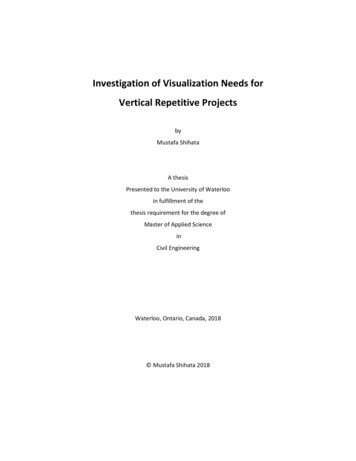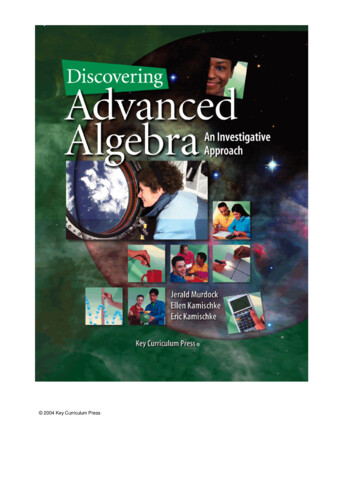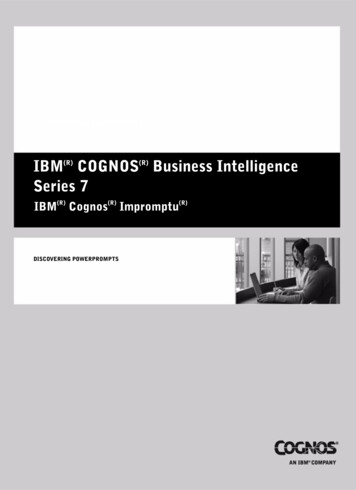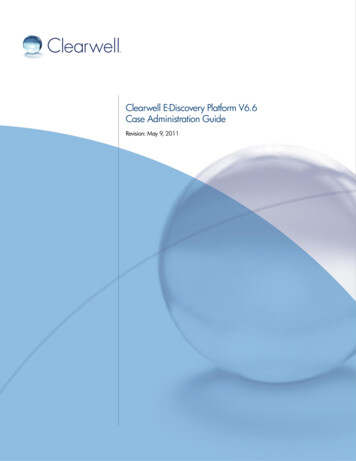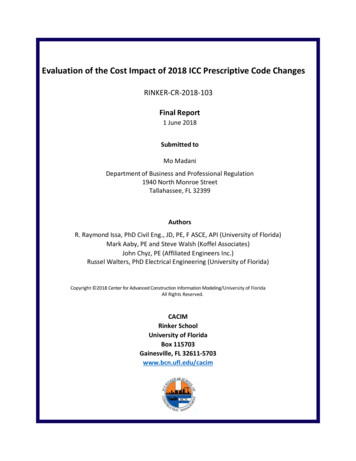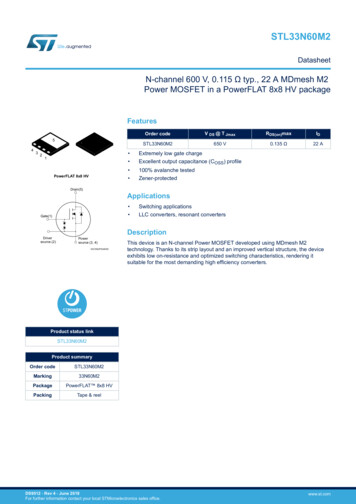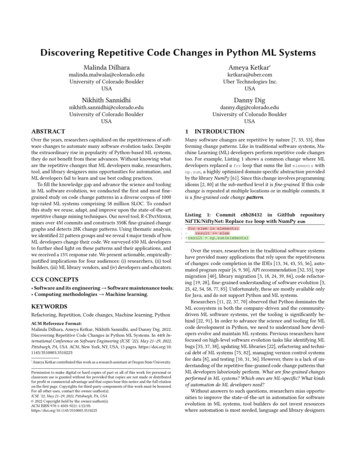
Transcription
Discovering Repetitive Code Changes in Python ML SystemsMalinda DilharaAmeya Ketkar malinda.malwala@colorado.eduUniversity of Colorado BoulderUSAketkara@uber.comUber Technologies Inc.USANikhith SannidhiDanny Dignikhith.sannidhi@colorado.eduUniversity of Colorado BoulderUSAdanny.dig@colorado.eduUniversity of Colorado BoulderUSAABSTRACT1Over the years, researchers capitalized on the repetitiveness of software changes to automate many software evolution tasks. Despitethe extraordinary rise in popularity of Python-based ML systems,they do not benefit from these advances. Without knowing whatare the repetitive changes that ML developers make, researchers,tool, and library designers miss opportunities for automation, andML developers fail to learn and use best coding practices.To fill the knowledge gap and advance the science and toolingin ML software evolution, we conducted the first and most finegrained study on code change patterns in a diverse corpus of 1000top-rated ML systems comprising 58 million SLOC. To conductthis study we reuse, adapt, and improve upon the state-of-the-artrepetitive change mining techniques. Our novel tool, R-CPatMiner,mines over 4M commits and constructs 350K fine-grained changegraphs and detects 28K change patterns. Using thematic analysis,we identified 22 pattern groups and we reveal 4 major trends of howML developers change their code. We surveyed 650 ML developersto further shed light on these patterns and their applications, andwe received a 15% response rate. We present actionable, empiricallyjustified implications for four audiences: (i) researchers, (ii) toolbuilders, (iii) ML library vendors, and (iv) developers and educators.Many software changes are repetitive by nature [7, 33, 53], thusforming change patterns. Like in traditional software systems, Machine Learning (ML) developers perform repetitive code changestoo. For example, Listing 1 shows a common change where MLdevelopers replaced a for loop that sums the list elements withnp.sum, a highly optimized domain-specific abstraction providedby the library NumPy [61]. Since this change involves programmingidioms [2, 80] at the sub-method level it is fine-grained. If this codechange is repeated at multiple locations or in multiple commits, itis a fine-grained code change pattern.CCS CONCEPTS Software and its engineering Software maintenance tools; Computing methodologies Machine learning.KEYWORDSRefactoring, Repetition, Code changes, Machine learning, PythonACM Reference Format:Malinda Dilhara, Ameya Ketkar, Nikhith Sannidhi, and Danny Dig. 2022.Discovering Repetitive Code Changes in Python ML Systems. In 44th International Conference on Software Engineering (ICSE ’22), May 21–29, 2022,Pittsburgh, PA, USA. ACM, New York, NY, USA, 13 pages. https://doi.org/10.1145/3510003.3510225 Ameya Ketkar contributed this work as a research assistant at Oregon State University.Permission to make digital or hard copies of part or all of this work for personal orclassroom use is granted without fee provided that copies are not made or distributedfor profit or commercial advantage and that copies bear this notice and the full citationon the first page. Copyrights for third-party components of this work must be honored.For all other uses, contact the owner/author(s).ICSE ’22, May 21–29, 2022, Pittsburgh, PA, USA 2022 Copyright held by the owner/author(s).ACM ISBN 10003.3510225INTRODUCTIONListing 1: Commit c8b28432 in GitHub repositoryNifTK/NiftyNet: Replace for loop with NumPy sum123- for elem in elements:result elem result np.sum(elements)Over the years, researchers in the traditional software systemshave provided many applications that rely upon the repetitivenessof changes: code completion in the IDEs [13, 34, 43, 55, 56], automated program repair [6, 9, 50], API recommendation [32, 55], typemigration [40], library migration [3, 18, 24, 39, 84], code refactoring [19, 28], fine-grained understanding of software evolution [3,25, 42, 54, 58, 77, 85]. Unfortunately, these are mostly available onlyfor Java, and do not support Python and ML systems.Researchers [11, 22, 37, 70] observed that Python dominates theML ecosystem in both the company-driven and the communitydriven ML software systems, yet the tooling is significantly behind [22, 91]. In order to advance the science and tooling for MLcode development in Python, we need to understand how developers evolve and maintain ML systems. Previous researchers havefocused on high-level software evolution tasks like identifying MLbugs [35, 37, 38], updating ML libraries [22], refactoring and technical debt of ML systems [75, 82], managing version control systemsfor data [8], and testing [10, 31, 36]. However, there is a lack of understanding of the repetitive fine-grained code change patterns thatML developers laboriously perform. What are fine-grained changesperformed in ML systems? Which ones are ML-specific? What kindsof automation do ML developers need?Without answers to such questions, researchers miss opportunities to improve the state-of-the-art in automation for softwareevolution in ML systems, tool builders do not invest resourceswhere automation is most needed, language and library designers
ICSE ’22, May 21–29, 2022, Pittsburgh, PA, USAcannot make informed decisions when introducing new constructs,and ML developers fail to learn and use best practices.In this paper, we conduct the first large-scale study and discoverrepetitive change patterns in Python-based ML systems. We employ both quantitative (mining repositories and thematic analysis)and qualitative methods (surveys) to answer the research questions. Blending these methods has the advantage of the resultsbeing triangulated. The quantitative methods help us discover whatfine-grained change patterns ML developers perform. The qualitative method helps us answer why these changes are performed,how they are performed, and how tool builders can improve MLdeveloper productivity.For the quantitative analysis, we use a large data set of 1000 MLprojects from GitHub, comprising 58 million source lines of code(SLOC) at the latest revisions, 1.16 million mapped code blocks, 1.5million changed files, and 0.4 billion changed SLOCs. We extracted28,308 fine grained code change patterns where 58% of them appearin multiple projects. We applied thematic analysis [12, 88] upon2,500 most popular patterns from our dataset, and categorized theminto 22 fine-grained change pattern themes that reveal 4 majortrends. Moreover, we designed and conducted a survey with 650ML developers, in which we presented 1,235 patterns for their feedback and achieved a 15% response rate. In the survey, 71% of thedevelopers confirmed the need of automation for 22 pattern groups.Among these, we discovered four major trends: (1) transform toContext managers (e.g., disable or enable gradient calculation, swapML training device), (2) convert for loops to domain specific abstraction (e.g., see Listing 1), (3) update API usage (e.g., migrate toTensorFlow.log from log, transform matrices), and (4) use advanced language features (e.g., transform to list comprehension).The main challenge in conducting such large-scale, representative studies, is the lack of tools for mining non-Java repositories.To overcome this challenge we reuse, adapt, and extend the vastecosystem of Java AST-level analysis tools [3, 25, 42, 54, 58, 77, 85] toPython. Most of these tools rely on techniques that are conceptuallylanguage-independent, i.e., they operate on intermediate representation of the code (e.g., AST nodes). Second, we observed that 72%of the Python AST node kinds identically overlap with those inJava (e.g., While-Statment, Assignment-Statement, etc.). Moreover,another 18% of Python AST node kinds also exist in Java with somedifferences (e.g., Python’s for loop has multiple loop variables).Only 10% of the Python AST node kinds are unique to Python (e.g.,With statement, Generators, etc.). Hence, one of our key ideas isto reuse the Java AST-level analysis tools to analyse 72% of thePython AST nodes and for the remaining 28% of AST nodes weeither modify existing capabilities or add brand new ones.We first developed a novel technique, JavaFyPy, to transformPython AST to a format that can be processed by Java AST-level mining tools. We used JavaFyPy to adapt to Python the state-of-the-artfine-grained change pattern mining tool, CPatMiner [58]. CPatMiner matches changed methods and their body statements acrossthe commits and identifies fine-grained change patterns. Refactorings such as move, rename, and extract method, re-arrange andobfuscate the code statements, that are hard to match across the edit,leading CPatMiner to miss multiple occurrences of patterns. Toimprove the accuracy of CPatMiner, we integrate it with the stateof-the-art refactoring mining technique- RefactoringMiner [85],Malinda Dilhara, Ameya Ketkar, Nikhith Sannidhi, and Danny Digthat de-obfuscates the re-arranged code statements. Our novel toolR-CPatMiner performs refactoring-aware, fine-grained change pattern mining in the commit history of Python systems.Our findings and tools have actionable implications for severalaudiences. Among others, they (i) advance our understanding ofrepetitive changes that the ML developers perform which helpsthe research community to improve the science and tools for MLsoftware evolution, (ii) provide a rich infrastructure to automateand significantly extend the scope of existing studies on ML systems [37, 38, 75], (iii) help tool builders comprehend the ML developers’ struggles and desire for automation, (iv) provide feedback tolanguage and API designers when introducing new ML constructs,and (v) assist educators in teaching ML software evolution.This paper makes the following contributions:(1) To the best of our knowledge, we conducted the first and thelargest study on fine-grained 28,308 code change patterns on MLsystems. We identified code changes patterns. We applied thematicanalysis on 2,500 most popular patterns and categorized them into22 fine-grained change pattern themes that reveal 4 major trends.(2) We designed and conducted a survey with 650 open-source MLdevelopers to provide insights about the reasons motivating thosechanges, the current practices of applying those changes, and theirrecommendation for tool builders.(3) We developed novel tools to collect fine-grained change patterns applied in the evolution history of Python-based ML systems.We applied these tools on 1000 open-source projects hosted onGitHub. We make the collected information and tooling publiclyavailable for reuse [21] so that we enable further research.(4) We present an empirically-justified set of implications of ourfindings from the perspective of four audiences: researchers, toolbuilders, language designers, and ML developers.2MOTIVATING EXAMPLEListing 2: Specifies the device (CPU) for operations executedin the context and move method init model to parent class12345678class FERNeuralNet(): def init model(self):with tf.device(’/cpu:0’): B, H, T, q.get shape().as list().class TimeDelayNN( FERNeuralNet):def init model(self):B, H, T, q.get shape().as list()The code change shown in Listing 2 specifies the hardware deviceusing tf.device() (line 3) for the TensorFlow operation in line4. tf.device() is a Context Manager [64] from the ML library,TensorFlow. This is a fine-grained code change and the developer hasinterleaved this with a Pull up Method refactoring that pulls init model from TimeDelayNN into the parent class FERNeuralNet.Is specifying hardware device for TensorFlow operations a pattern? How frequent is this pattern? Do developers need tool supportto recommend and automate this code change pattern? We considerthis fine-grained code change instance a repeated pattern if a similarcode change was performed in the history of this project or anyother project. Researchers have proposed advanced techniques tomine such fine-grained change patterns from the commit histories [58, 59]. However, these techniques are inapplicable to mine
Discovering Repetitive Code Changes in Python ML SystemsPython codePython parser(Jython)ICSE ’22, May 21–29, 2022, Pittsburgh, PA, USASyntaxtransformerTypeaugmenter1Eclipse JDTJava parserAST2Design of JavaAST analysis toolsMiningAlgorithmASTCustomized EclipseJDT Java parserDesign of JavaFyPyFigure 1: Design of JavaFyPy and existing AST analysis toolsthe fine-grained code change patterns shown in Listing 2 because (1)their techniques mine code change patterns for Java, and (2) theydo not account for overlapping refactorings.Researchers [51, 52, 78] have shown that developers often interleave many programming activities such as bug fixes, featureadditions, or other refactoring operations, and often these changesoverlap [54] (as shown in Listing 2). Such overlapping changesand refactorings can easily obfuscate existing fine-grained changepattern mining tools [58, 59] because they do not account for thesechanges when matching code across the commit. For example, CPatMiner [58] does not match the method body of init model inthe class FERNeuralNet (lines 3–4) to the body of init modelin the class TimeDelayNN (line 7) as they are in different locationsand different files. This lack of refactoring awareness is a serious limitation of existing pattern mining algorithms because they can missseveral concrete instances of change patterns that are obfuscatedby overlapping refactorings.Re-implementing the existing Java AST mining tools for Pythonwill require a significant amount of development effort. It is alsoneither feasible nor sustainable as researchers are continuouslyimplementing new Java AST mining tools or improving existingtools. For this purpose, we propose JavaFyPy, a technique to adaptexisting Java AST mining tools to Python that leverages the similarity between the Java and Python abstract syntax trees (AST). Weuse JavaFyPy to adapt the state-of-the-art fine-grained change pattern mining tool, CPatMiner [58], to Python. To make CPatMinerrefactoring aware, we adapt the state-of-the-art Java refactoring inference tool, RefactoringMiner [85] (known as RMiner), to Pythonand integrate it with CPatMiner as R-CPatMiner. Particularly,the code-block mapping pairs (i.e., two versions of the same codeblock in a method before and after the change) reported by RMinerare provided as input to CPatMiner. R-CPatMiner mines changepatterns in Python software systems in a refactoring-aware manner.3TECHNIQUEMost of the current code change mining tools (i.e. AST mining tools)are conceptually language-independent because they operate uponthe abstract syntax trees (AST) only. However, their implementationis bound only to Java. To overcome this practical implementationlimitation, we propose a very pragmatic solution - JavaFyPy, atechnique that transforms the input Python program to an ASTthat can be processed by the mining algorithm of existing JavaAST analysis tools. JavaFyPy will fast-track researchers and toolbuilders by making the AST-based mining tools implemented forJava programs applicable for Python programs. Thus, it will saveseveral development-hours of work required for re-implementingthese techniques. As shown in 1 in Figure 1, JavaFyPy takes aPython code as an input and produces an AST, that can be usedin mining algorithms of Java AST analysis tools. To achieve this,JavaFyPy first transforms the Python code to AST and enriches theAST by augmenting type information. Then, the Syntax transformermaps the corresponding Java concrete syntax to the AST nodes. TheJava parser (Eclipse JDT) uses it to produce the final AST. EclipseJDT is the most popular Java parser used in AST mining researchtools. Therefore, we selected Eclipse JDT as the parser that producesthe final AST. This enhanced and enriched AST can be processed bythe mining algorithms of Java AST analysis tools. Tool builders andresearchers can use JavaFyPy, and extend their tools for Python.3.1Python code transformationAs shown in Figure 2 JavaFyPy first parses the input Python program to an AST. We define an AST as:Definition 3.1. (AST) Let T be an AST. T has one root. Each nodeNi T has a parent (except the root node). Each node (Ni T)has a sequence of child nodes (denoted by CNi ). Number of nodesin the sequence CNi is denoted by LengthCNi . Each node Ni isa specific syntax category known as AST node kind, KindNi {Assignment Statement, For statement, Method Invocation . . . }.We leverage the syntactic similarity between Python and Javato adapt the Java AST analysis tools to Python. We thoroughlystudied the Java and Python language specifications [62, 67] andmapped the Python AST node kinds to those in Java based on thedescription in the specifications.Definition 3.2. (Mapped AST node) Let Tj be a Java AST andTp be a Python AST. Nj Tj, Np Tp . We state that Nj and Npare mapped AST node kind, if Nj and Np maintain a structuralsimilarity. Mapped node of node Np is denoted by M(Np ) Nj .We found three kinds of mappings namely, Identical AST node,Nearly identical AST node, and Unique AST node.Definition 3.3. (Identical AST node) Let CNj be a sequence ofchild AST nodes of a parent Java node Nj and CNp be a sequenceof child AST nodes of a Python node Np . We state that Nj and Npare identical AST nodes if (i) M(Np ) is Nj , and (ii) Ni CNp :M(Np ) CNj .(1) Identical AST node (Definition 3.3) - 72% of the Python’s ASTnode Kinds can be identically mapped to a Java’s AST Node. Forexample, we mapped Python’s If to Java’s If Statement and mappedPython’s Assign to Java’s AssignmentStatement.Definition 3.4. (Nearly Identical AST node) We state that Nj andNp as nearly identical AST nodes, if Nj and Np meets conditions:(i) M(Np ) is Nj , and (ii) Ni CNp : M(Ni ) CNj .(2) Nearly identical AST node (Definition 3.4) - 18% of Python’sAST Node kinds could be partially mapped to those of Java. Forinstance, both Python and Java provide the for construct to iterateover a collection, however unlike Java, Python allows to iterateover multiple variables (see the for loop in Figure 2), thus AST ofPython for loop contains additional child AST node kinds.Definition 3.5. (Unique AST node) Let Np be a Python AST node.We state that Np is unique to Python, if there is no mapped ASTnode in Tj . i.e., (M(Np ) Tj ).
ICSE ’22, May 21–29, 2022, Pittsburgh, PA, USAfor x, y in iter:z x yMalinda Dilhara, Ameya Ketkar, Nikhith Sannidhi, and Danny DigFor StatementFor StatementExpression (y)Expression (iter)Blockyield zAssignment statement (x x y)Expression (x)Yield StatementPython ASTfor (int x,int y:iter){Variable Declaration (int x))z x y;Expression (iter)BlockAssignment statement (x x y)yield z;Variable Declaration (int y)Yield StatementCoustomizedJDT Parser}Type augmented Python ASTTransformed CodeFigure 2: An example Code transformation performed by JavaFyPy(3) Unique AST node - 10% of the Python nodes had no Java counterpart. For instance, Java does not support list comprehensionsor yield statement (as shown in Figure 2)As we can observe, Java and Python syntax significantly overlaps.As shown in 2 in Figure 1, AST mining tools like CPatMiner andRMiner parse the input program to Eclipse JDT AST. To adapt theirtools to Python with JavaFyPy, tool builders or researchers simplyneed to migrate their Java parser to our technique (JavaFyPy). Afterthat, we can simply reuse tools’ AST-based mining algorithms toanalyse 72% of the Identical AST node kinds, and modify the currentimplementation to accommodate the 18% Nearly identical AST nodekinds and add brand-new capabilities (often involving adding newvisitors) for handling the 10% Unique AST node kinds. After thechanges, the tools take Python code as an input and infer the results,thus adapting Java AST mining tools to Python.Figure 2 shows an example of the code transformation steps(shown in Figure 1) that JavaFyPy performs automatically. ThePython code snippet in Figure 2 contains all three AST node kinds:Identical AST node (z x y), Nearly identical AST node (forloop), and Unique AST node (yield z). The Java parser first constructs the AST of the code snippet, then the Type Augmenter augments the AST with type information by adding Variable Declarationnodes. This step is important because the Java-based AST miningtools [58, 85] rely on the syntactic richness that the Java languageoffers. Unlike Python, Java programmers have to explicitly declarethe types of variables, fields and methods. To add this syntacticrichness to the input program, JavaFyPy augments the AST of theinput program with type information (shown in Figure 2 as rednodes). We obtain the type information from PyType [30], the stateof-the-practice type inference tool for Python developed by Google,which is widely adopted by the Python community. As the last step,Syntax Transformer transforms the AST to code and passes it toour customized Eclipse JDT parser which we extended to parseNearly identical AST node kinds and Unique AST node kinds.Can JavaFyPy effectively transform all Identical, Nearly Identical,and Unique AST node kinds? We evaluated this empirically with14 popular Python projects including TensorFlow, PyTorch, Keras,NLTK, Scikit learn, Scipy, and NumPy that comprise 23K Pythonfiles and 2.9M SLOC. We checked whether all AST nodes, i.e., Identical AST nodes, Nearly identical AST nodes and Unique AST nodeswere successfully mapped and transformed to the output AST ofJavaFyPy. We achieved this by transforming all of the Python filesin the projects, which had 12M Python AST nodes. This confirmsthat JavaFyPy can effectively transform any input Python programto an Eclipse JDT AST format.3.2Refactoring Aware Change Pattern Mining3.2.1 Adapting CPatMiner. CPatMiner [58] is the state-of-theart code change pattern mining tool that uses an efficient graphbased representation of code changes to mine previously unknownfine-grained changes from git commit history. It iterates over changedmethods in each commit and uses Eclipse JDT Java parser [27]to generate an AST of Java source code. Then, its mining algorithm builds program-dependence graphs for each AST node independently and then merges the graphs to create one big graph,called change graph. CPatMiner builds change graphs for eachchanged method, and it represents the before and after a sourcecode change that can be used to mine code change patterns. Since72% of the Python AST node kinds overlap identically with thosein Java, we reused most of the capabilities for building the changegraphs. We added new capabilities in CPatMiner to create programdependence graphs for Unique AST nodes, and modified the existingcapabilities of Nearly identical AST nodes. Overall, we extendedCPatMiner with 2% extra code lines due to the new or modifiedcapabilities, and reused the rest of the code. While this ratio mightbe different when adapting other tools, it showcases the merit ofJavaFyPy to reuse Java AST-based mining tools for Python.3.2.2 Introducing Refactoring Awareness. As discussed in Section 2, CPatMiner [58] does not account for the overlapping refactorings applied in the commit. These refactorings move code blocksbetween methods or change the method signature, making it hardto match the changed code blocks. Thus missing the opportunitiesto build change graphs for the obfuscated changes. To overcome this,we made the CPatMiner refactorings aware by integrating it withRMiner [85]. We used JavaFyPy to adapt RMiner and use it to detect 18 refactoring kinds that move code blocks. RMiner uses ASTbased statement matching algorithm to match classes, methods, andstatements inside method bodies, thus helping us match moved codeblocks. We consult the authors of RMiner and extend its statementmatching algorithm to reason about the Unique and Nearly identicalAST Node kinds. For example, Listing 3 shows a variable renamerefactoring in List Comprehension, a Python Unique AST node kindof the project "Deepmedic" detected by Python-adapted RMiner.Listing 3: Commit 8d4be555 in DeepMedic: Variable renamein List Comprehension detected by Python-adapted RMiner12- indices [ layerNum - 1 for layerNum in layers norm] indices [ layer num - 1 for layer num in layers norm]We use Python adapted RMiner to accurately match the movedcode blocks. We extended CPatMiner to build change graphs forthe code block pairs reported by RMiner. Hence, CPatMiner nolonger misses obfuscated code-blocks that contain fine-grainedchanges. We developed the tool R-CPATMiner, to efficiently and
Discovering Repetitive Code Changes in Python ML SystemsICSE ’22, May 21–29, 2022, Pittsburgh, PA, USAaccurately mines source code change patterns in the version histories of Python software systems, in a refactoring-aware manner.4RESEARCH METHODOLOGYWe prefix all the adapted tool names with Py to disambiguate thetool names from their Java counterparts. We first evaluate the effectiveness of the tools we developed (or adapted). Then, we use ourreliable and validated tools , to explore the repetitive code changesapplied in Python ML Systems. For this purpose, we answer threeresearch questions:RQ1. What are the frequent code change patterns in ML code, andwhat patterns need automation? To answer this research question,we triangulate complementary empirical methods, as shown in Figure 3. (i) We mined 1000 repositories using R-CPatMiner andextracted 28,308 patterns, (ii) We applied thematic analysis on 2,500patterns, (iii) We sent a survey to 650 ML developers to seek theiropinion on automating the identified code change patterns.RQ2. How does the refactoring awareness improve the pattern miningover the baseline CPatMiner? R-CPatMiner performs refactoringaware change pattern mining, thus improving baseline CPatMiner.Compared to CPatMiner, does R-CPatMiner extract (i) morechange graphs? (ii) more code change patterns? and (iii) more codeinstances per pattern?RQ3. What is the runtime performance of R-CPatMiner, PyCPatMiner, and PyRMiner? To answer this, we compare the executiontime of the Python adapted tools with their Java counterparts.1000 sChange patternsfor the surveyOnlinesurveyAutomationsuggestions fortool buildersFigure 3: Schematic diagram of the research methodology toanswer RQ34.1Subject systemsOur corpus consists of 4,166,520 commits from 1000 large, mature,and diverse ML application systems, comprising 58M lines of sourcecode and 150K Python files, used by other researchers [22] to understand the challenges of evolving ML systems. This corpus [22] isshown to be very diverse from the perspective of Python files, LOC,contributors, and commits. They vary widely in their domain andapplication, include a mix of frameworks, web utilities, databases,and robotics software systems that use ML. Further we added lowlevel ML libraries [10] such as Scipy, SpaCy, and high-level MLlibraries [10] such as Keras, PyTorch, Caffe, NLTK, and Theano toour subject systems. This ensures our dataset is representative andlarge enough to answer our research questions comprehensively.4.2Static Analysis of Source Code History4.2.1 Change pattern identification: Running R-CPatMineron the ML corpus extracted 28,308 unique code change patterns,where 58% of them have code change instances in multiple projects,63% of them have been performed by multiple authors.Since the mined patterns are numerous, we followed the bestpractices from Negara et al. [53]. They ordered the patterns alongthree dimensions - by frequency of the pattern (F), by the size of thepattern (S), and by F S. Since the repetitive changes done by several developers and projects are stable [59] and have a higher chanceof being automated, we also considered the number of projects andauthors as extra two dimensions. Then we ordered the mined patterns along all five dimensions. Then, two of the authors who havemore than three years of professional software development experience and extensive expertise in software evolution, manuallyinvestigated the top 500 patterns for each of the five dimensionsand identified meaningful code patterns, i.e., the patterns that canbe described as high-level program transformations.Two authors of the paper manually analyzed each change pattern, to identify the high-level programming task performed inthe change patterns. Following the best practices guidelines fromthe literature, the authors used negotiated agreement techniqueto achieve agreement [14, 88]. Two authors of the paper independently coded the change patterns carefully and assigned one or moredescriptive phrases (i.e., codes) to the patterns. Both authors conducted the initial meeting after coding around 25% of the data (thesuggested minimum size is 10% [14]). During the meeting, the authors carefully discussed the coding process of all the patterns. Also,they negotiated any disagreements between the assigned codes andthe patterns that cannot be described as high-level program transformations. After 80% inter-coder agreement was achieved (recommended inter-coder agreement level ranges from 70% to morethan 90% in the literature [14]), the two authors independentlycoded the remaining change patterns. This process identified allthe patterns for which the two authors were able to agree upon theunderlying meaning of the pattern. After the coding finished, theauthors held another meeting in order to finalize the codes and extract themes. Themes capture something important about the datain relation to the meaning of the pattern. It also represents somelevel of patterned response or meaning within the data set [12]. Thetwo authors reviewed the initial themes against the data severaltimes and refined their names and definitions until they both agreedthat there were no further refinements possible. We identified fourtrends (themes) of patterns based on their structural similarity atthe statement and expre
differences (e.g., Python'sfor loop has multiple loop variables). Only 10% of the Python AST node kinds are unique to Python (e.g., With statement, Generators, etc.). Hence, one of our key ideas is to reuse the Java AST-level analysis tools to analyse 72% of the Python AST nodes and for the remaining 28% of AST nodes we
